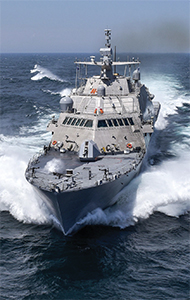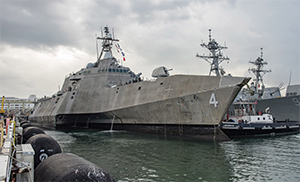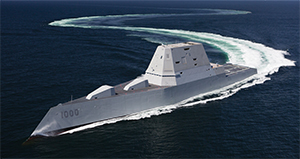As the calendar flipped to September, all eyes in the world of military shipbuilding turned intently to Washington as the Coast Guard prepared to deliver the biggest procurement plum in decades: a contract potentially worth $10 billion to build up to 25 offshore patrol cutters.
Late on Sept. 15, champagne corks began flying in Panama City, Fla. Eastern Shipbuilding Group, a family-held company with a long record of delivering commercial vessels on time and on budget, had been selected over rivals Bollinger Shipyards and Bath Iron Works to deliver the new class of ships.
“The offshore patrol cutter acquisition is the Coast Guard’s highest investment priority, and we are proud to announce this important milestone,” said Adm. Paul Zukunft, commandant of the Coast Guard, in a prepared statement. “The offshore patrol cutter will replace our aging medium endurance cutters and provide the majority of offshore presence by the Coast Guard’s cutter fleet.”
The initial award was $110.2 million for the production of the lead OPC, with the contract worth up to $2.3 billion for eight additional cutters, the Coast Guard said. The service plans to build 25 OPCs, which would bring the value to $10 billion.
 |
|
The Coast Guard’s new offshore patrol cutter, designed by Vard Marine, will be built by Eastern Shipbuilding under terms of a deal worth up to $10 billion. |
|
Courtesy Eastern Shipbuilding Group |
The new ships will replace the 210-foot and 270-foot medium endurance cutters that the Coast Guard deploys for security operations, drug interdictions and search-and-rescue missions. The vessels being phased out, some of them more than 50 years old, “are in many respects technologically obsolete,” the Coast Guard states in an OPC fact sheet.
The new cutters will be 360 feet long and 54 feet wide. They will have a top speed of more than 22 knots and will be capable of carrying an MH-60R or MH-65 helicopter, according to Eastern. They also will have a “highly sophisticated” combat system and communications suite. Construction of the lead ship is expected to begin in 2018, with delivery in fiscal year 2021.
Of the three bidders, Bath Iron Works had the most on the line. Bollinger already produces cutters for the Coast Guard and Eastern has a history of diversity when it comes to new construction, but BIW is heavily reliant on building destroyers for the Navy — work that is likely to drop off amid shifting defense priorities.
BIW officials warned last year as they were preparing to negotiate a new labor contract that the shipyard might have to cut 1,000 jobs if it didn’t win the OPC contract. The yard is one of Maine’s largest private employers with more than 5,500 workers.
 |
|
The Navy cited Lockheed Martin and Marinette Marine in 2015 for propulsion system “cleanliness” issues on the littoral combat ships USS Detroit, above, and USS Milwaukee. |
|
Courtesy U.S. Navy |
Icebreaker proposal makes headway
In January, the Coast Guard released an acquisition timeline and requirements for two new heavy icebreakers that will cost an estimated $1 billion each. The nation currently has just one active heavy icebreaker, Polar Star, and a medium icebreaker, Healy, that is deployed primarily for scientific research. A second heavy icebreaker, Polar Sea, suffered an engine casualty in 2010 and has been non-operational since then.
President Obama’s fiscal 2017 budget included $150 million to complete design work on a new icebreaker, laying “a trackline to rebuild the polar capabilities the nation needs in the 21st century,” Zukunft told the House homeland security subcommittee in March. In May, the Senate Appropriations Committee set aside $1 billion for the vessel, with construction expected to begin in 2020. The U.S. lags far behind Russia, which has more than 40 icebreakers.
The Coast Guard planned to release a draft request for proposals in the first quarter of fiscal 2017 and award a contract in the last quarter of fiscal 2018 or in fiscal 2019. Ship requirements include the ability to break through ice 6 feet thick at a continuous speed of 3 knots.
Littoral combat ships under fire
The past year has been a difficult one for the LCS program. In addition to suffering four propulsion casualties at sea — USS Freedom, USS Coronado, USS Milwaukee and USS Fort Worth — the Government Accountability Office (GAO) cited “fundamental weaknesses” in the program and said Congress should consider not funding littoral combat ships in fiscal 2017. The report came after a Navy panel studied modifying both the Freedom and Independence variants and designating them as frigates.
 |
|
USS Coronado was forced to return to Pearl Harbor in August after suffering a propulsion casualty at sea. |
|
Courtesy U.S. Navy |
“The Navy’s task force studied a number of options to improve upon known shortfalls in littoral combat ship lethality and survivability,” the GAO said. “It found that neither LCS variant with minor modifications met the Navy’s desired capabilities without further tradeoffs.” The report went on to state that “as the Navy pivots from the LCS to the frigate program, which is estimated to cost more than $8 billion for ship construction alone, its approach would require Congress to appropriate funding with key unknowns.”
Shipbuilders Marinette Marine (Freedom variant) and Austal USA (Independence variant) also faced blowback from Defense Secretary Ash Carter, who decreed in December that the LCS/frigate program would be halted at 40 ships instead of the planned 52, and that only one shipyard would finish the work. Navy Secretary Ray Mabus rebutted Carter in March, telling the House Appropriations defense subcommittee that decisions about what to do “will not be made by this administration. They will be made by the next administration and by Congress.”
In May, the Navy said its supervisor of shipbuilding had issued three “corrective action requests” to Lockheed Martin, the lead company in production of the Freedom variant, that hadn’t been previously disclosed. The citations were for inadequate oversight of propulsion systems, an “inability to adequately control critical system cleanliness” on those systems for USS Milwaukee and USS Detroit, and a failure by Lockheed and Marinette Marine “to ensure adequate subcontractor oversight.”
LCS production continued throughout the year at Marinette and Austal, however, with newbuilds from both companies joining a slew of other military hulls to hit the water for active duty. Here is a look at some of the activity in the U.S. and Canada:
 |
|
USNS Carson City, an expeditionary fast transport, performs during builder’s trials in May in the Gulf of Mexico. |
|
Courtesy U.S. Navy |
General Dynamics NASSCO
The San Diego shipyard laid the keel in August for USNS Hershel “Woody” Williams, the U.S. Navy’s second expeditionary sea base (ESB). NASSCO delivered the first ESB, USNS Lewis B. Puller, to the Navy in 2015.
The 784-foot Williams will serve as a flexible platform to support counterpiracy, maritime security and humanitarian missions. In addition to accommodations for 250, it will have expansive fuel and equipment storage and a 52,000-square-foot flight deck for MH-53 and MH-60 helicopters, with an option to support MV-22 tilt-rotor aircraft. NASSCO expects to complete the ship in the first quarter of 2018.
Bollinger Shipyards
The Lockport, La.-based shipbuilder delivered five fast response cutters (FRCs) to the Coast Guard in the past year: Joseph Napier, Winslow Griesser, Donald Horsley, Joseph Tezanos and Rollin Fritch. In May, Bollinger received a contract to build up to 26 additional Sentinel-class cutters. The initial $318.6 million award covers production of six of the 154-foot ships, but the contract has a potential value of $1.42 billion if all options are exercised.
In December, the U.S. Justice Department announced that Bollinger would pay $8.5 million to settle a lawsuit alleging that the shipbuilder falsely represented the strength of cutters lengthened from 110 to 123 feet in a project more than a decade ago. The government alleged that the shipyard only provided the Coast Guard with the highest and most inaccurate calculations of longitudinal strength, resulting in hulls buckling and failing once the vessels were put into service.
 |
|
Ingalls Shipbuilding delivered John P. Murtha to the Navy in May. It is the 10th San Antonio-class amphibious transport dock from the Mississippi shipbuilder. |
|
Courtesy Huntington Ingalls Industries |
Austal USA
Austal’s yard in Mobile, Ala., produced four ships for the U.S. Navy in the past year: the littoral combat ships USS Jackson (LCS 6) and USS Montgomery (LCS 8), and the expeditionary fast transports USNS Brunswick (EPF 6) and USNS Carson City (EPF 7). The EPFs formerly were designated as joint high speed vessels (JHSVs).
The shipbuilder took a hit in January when it was reported that a design change that the Navy adopted at the recommendation of Austal left the JHSVs vulnerable to wave slam, resulting in bow damage to four ships that cost more than $2 million to repair. “The Navy accepted compromises in the bow structure, presumably to save weight” during the construction of the aluminum catamarans, Michael Gilmore, the Pentagon’s chief weapons tester, wrote in a letter to top members of House and Senate defense committees.
Marinette Marine
The Wisconsin shipyard delivered USS Milwaukee (LCS 5) and USS Detroit (LCS 7) for Navy service, with five other ships in the class in the works as of late August. Little Rock (LCS 9) was preparing for sea trials, Sioux City (LCS 11) was conducting system testing in anticipation of trials, and Wichita (LCS 13) was being prepared for a launch this fall. The keel was laid for Billings (LCS 15) in November 2015 and fabrication continued on Indianapolis (LCS 17). Other ships in pre-production include St. Louis (LCS 19), Minneapolis-St. Paul (LCS 21), Cooperstown (LCS 23) and the as yet unnamed LCS 25.
Huntington Ingalls
Ingalls Shipbuilding of Pascagoula, Miss., delivered a pair of amphibious transport docks to the Navy, John P. Murtha (LPD 26) and Portland (LPD 27). Three national security cutters (NSCs) were under construction at the yard in September, with Munro (WMSL 755) slated for delivery in the fourth quarter. The omnibus spending bill passed by Congress in December included $640 million for a ninth national security cutter, even though the Coast Guard had said eight was sufficient. All have been built by Ingalls.
 |
|
USNS Hershel “Woody” Williams, the Navy’s second expeditionary sea base, is slated for delivery in 2018 by General Dynamics NASSCO. |
|
Courtesy General Dynamics NASSCO |
Bath Iron Works
The Maine yard delivered perhaps the most interesting ship of the year in May: the futuristic USS Zumwalt (DDG 1000), the Navy’s most technologically advanced surface ship. The 610-foot stealth destroyer has a unique radar-defeating superstructure and wave-piercing tumblehome hull. It also has an integrated power system to generate 78 megawatts for ship service, nearly what a nuclear-powered aircraft carrier generates, according to the Navy.
Irving Shipbuilding
In June, the Halifax, Nova Scotia, shipbuilder laid the keel for HMCS Harry DeWolf, the first in a new class of Arctic and offshore patrol ships (AOPS) for the Royal Canadian Navy. Six of the 340-foot vessels will be built as part of Canada’s $40 billion National Shipbuilding Procurement Strategy, one of the largest capital projects ever undertaken by the federal government. Steel was cut in August for the second ship in the class, HMCS Margaret Brooke.
Chantier Davie Canada
An unsolicited bid from Quebec-based Davie to build icebreakers for the Canadian Coast Guard was rejected in March by the federal government. Davie’s offer had the potential to undercut the national strategy that designates Irving to build combat ships and Vancouver’s Seaspan to build non-combatants.

